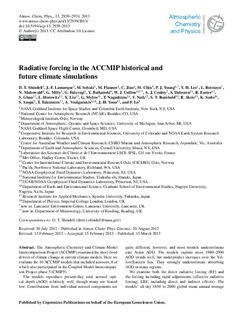| dc.description.abstract | The Atmospheric Chemistry and Climate Model Intercomparison Project (ACCMIP) examined the short-lived drivers of climate change in current climate models. Here we evaluate the 10 ACCMIP models that included aerosols, 8 of which also participated in the Coupled Model Intercomparison Project phase 5 (CMIP5). The models reproduce present-day total aerosol optical depth (AOD) relatively well, though many are biased low. Contributions from individual aerosol components are quite different, however, and most models underestimate east Asian AOD. The models capture most 1980–2000 AOD trends well, but underpredict increases over the Yellow/ Eastern Sea. They strongly underestimate absorbing AOD in many regions. We examine both the direct radiative forcing (RF) and the forcing including rapid adjustments (effective radiative forcing; ERF, including direct and indirect effects). The models’ all-sky 1850 to 2000 global mean annual average total aerosol RF is (mean; range) −0.26Wm−2; −0.06 to −0.49Wm−2. Screening based on model skill in capturing observed AOD yields a best estimate of −0.42Wm−2; −0.33 to −0.50Wm−2, including adjustment for missing aerosol components in some models. Many ACCMIP and CMIP5 models appear to produce substantially smaller aerosol RF than this best estimate. Climate feedbacks contribute substantially (35 to −58 %) to modeled historical aerosol RF. The 1850 to 2000 aerosol ERF is −1.17Wm−2; −0.71 to −1.44Wm−2. Thus adjustments, including clouds, typically cause greater forcing than direct RF. Despite this, the multi-model spread relative to the mean is typically the same for ERF as it is for RF, or even smaller, over areas with substantial forcing. The largest 1850 to 2000 negative aerosol RF and ERF values are over and near Europe, south and east Asia and North America. ERF, however, is positive over the Sahara, the Karakoram, high Southern latitudes and especially the Arctic. Global aerosol RF peaks in most models around 1980, declining thereafter with only weak sensitivity to the Representative Concentration Pathway (RCP). One model, however, projects approximately stable RF levels, while two show increasingly negative RF due to nitrate (not included in most models). Aerosol ERF, in contrast, becomes more negative during 1980 to 2000. During this period, increased Asian emissions appear to have a larger impact on aerosol ERF than European and North American decreases due to their being upwind of the large, relatively pristine Pacific Ocean. There is no clear relationship between historical aerosol ERF and climate sensitivity in the CMIP5 subset of ACCMIP models. In the ACCMIP/CMIP5 models, historical aerosol ERF of about −0.8 to −1.5Wm−2 is most consistent with observed historical warming. Aerosol ERF masks a large portion of greenhouse forcing during the late 20th and early 21st century at the global scale. Regionally, aerosol ERF is so large that net forcing is negative over most industrialized and biomass burning regions through 1980, but remains strongly negative only over east and southeast Asia by 2000. Net forcing is strongly positive by 1980 over most deserts, the Arctic, Australia, and most tropical oceans. Both the magnitude of and area covered by positive forcing expand steadily thereafter. | |
